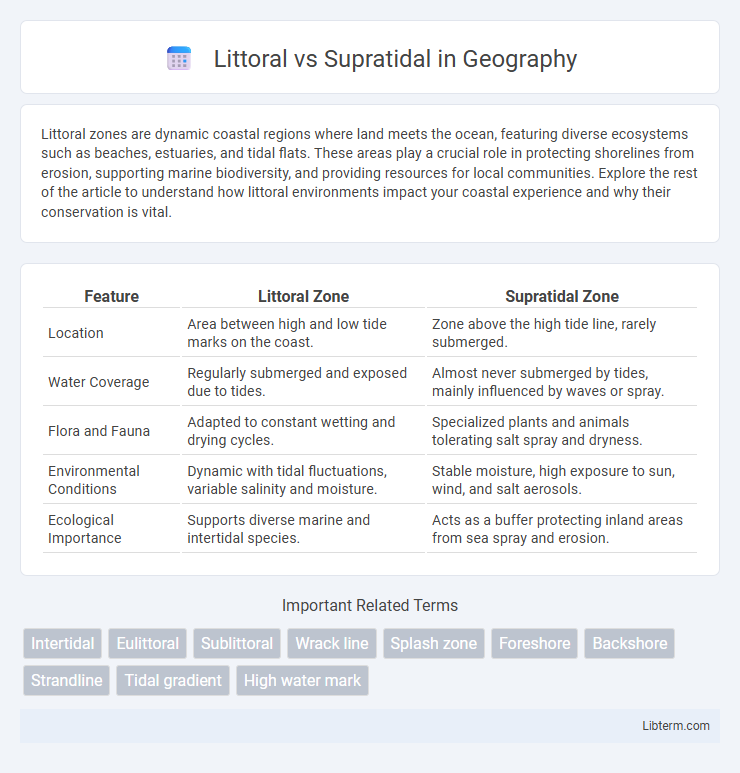Littoral zones are dynamic coastal regions where land meets the ocean, featuring diverse ecosystems such as beaches, estuaries, and tidal flats. These areas play a crucial role in protecting shorelines from erosion, supporting marine biodiversity, and providing resources for local communities. Explore the rest of the article to understand how littoral environments impact your coastal experience and why their conservation is vital.
Table of Comparison
| Feature | Littoral Zone | Supratidal Zone |
|---|---|---|
| Location | Area between high and low tide marks on the coast. | Zone above the high tide line, rarely submerged. |
| Water Coverage | Regularly submerged and exposed due to tides. | Almost never submerged by tides, mainly influenced by waves or spray. |
| Flora and Fauna | Adapted to constant wetting and drying cycles. | Specialized plants and animals tolerating salt spray and dryness. |
| Environmental Conditions | Dynamic with tidal fluctuations, variable salinity and moisture. | Stable moisture, high exposure to sun, wind, and salt aerosols. |
| Ecological Importance | Supports diverse marine and intertidal species. | Acts as a buffer protecting inland areas from sea spray and erosion. |
Introduction: Defining Littoral and Supratidal Zones
Littoral zones are coastal regions directly influenced by tidal actions, encompassing areas between high and low tide marks where marine and terrestrial ecosystems interact. Supratidal zones lie above the high tide line, remaining mostly dry but influenced by wave splash and salt spray, supporting distinct plant and animal communities adapted to these saline, less frequently submerged conditions. Understanding these zones is crucial for coastal ecology, erosion studies, and habitat conservation efforts.
Geographical Locations of Littoral and Supratidal Areas
Littoral zones are coastal regions found between high and low tide marks, commonly located along ocean shores, bays, and estuaries where marine and terrestrial ecosystems meet. Supratidal areas lie above the high tide line, often including coastal dunes and salt marshes found in regions with significant tidal ranges such as the Atlantic coasts of the United States and northern Europe. Both zones are crucial for coastal biodiversity, with littoral areas experiencing regular inundation and supratidal zones subject to occasional salt spray and storm surges.
Key Physical Differences Between Littoral and Supratidal Zones
The littoral zone is the coastal area directly influenced by tidal action, characterized by regular submersion and exposure, supporting diverse marine life adapted to fluctuating water levels. In contrast, the supratidal zone lies above the high tide line, rarely submerged, dominated by terrestrial influences and often subject to salt spray and wind rather than direct wave action. Key physical differences include tidal inundation frequency, sediment moisture content, and the presence of marine versus terrestrial vegetation, with the littoral zone exhibiting more dynamic hydrological conditions compared to the relatively stable supratidal environment.
Tidal Influence on Littoral vs Supratidal Environments
Littoral zones experience regular tidal inundation, which shapes sediment deposition, nutrient cycling, and marine organism distribution, creating a highly dynamic and biologically productive environment. In contrast, supratidal zones lie above the high tide line, where tidal influence is minimal and primarily indirect, resulting in lower moisture levels and distinct vegetation adapted to sporadic saltwater spray and occasional storm surge. This difference in tidal impact drives contrasting ecological processes and habitat types between littoral and supratidal environments.
Unique Flora in the Littoral and Supratidal Zones
The littoral zone hosts unique flora such as mangroves, seaweeds, and salt-tolerant grasses adapted to frequent tidal inundation and saline conditions. In contrast, the supratidal zone supports halophytic plants like saltbush, succulents, and coastal shrubs that thrive in less frequent saltwater exposure and drier, more stable soils. Both zones exhibit specialized vegetation crucial for coastal ecosystem stability and biodiversity.
Fauna Adaptations: Littoral vs Supratidal Species
Littoral zone species exhibit adaptations such as strong attachment mechanisms and tolerance to periodic submersion, allowing survival amid fluctuating tides and wave action. Supratidal species demonstrate traits like desiccation resistance and burrowing behavior to cope with infrequent water exposure and high salinity levels. These distinct adaptations reflect evolutionary responses to the varying moisture, salinity, and exposure gradients in littoral versus supratidal environments.
Human Activities and Impacts in Each Zone
Human activities in the littoral zone, such as fishing, tourism, and coastal development, directly affect marine ecosystems through habitat destruction, pollution, and overharvesting. In the supratidal zone, human impacts include construction of seawalls, land reclamation, and recreational use, leading to altered drainage patterns, erosion, and loss of native vegetation. Both zones experience increased vulnerability to climate change effects, including sea level rise and storm surges, which exacerbate human-induced environmental stress.
Ecological Importance of Littoral and Supratidal Zones
The littoral zone, located between high and low tide marks, supports diverse marine ecosystems by providing critical habitats for intertidal species and acting as a nursery for fish and invertebrates. The supratidal zone, positioned above the high tide line, offers essential refuge for terrestrial and semi-aquatic organisms, stabilizes shorelines through vegetation like salt marsh plants, and serves as a buffer against coastal erosion and storm surges. Both zones play pivotal roles in nutrient cycling, biodiversity conservation, and coastal resilience.
Conservation Strategies for Littoral vs Supratidal Areas
Conservation strategies for littoral areas emphasize protection against erosion, pollution control, and habitat restoration due to their dynamic interaction with tidal forces and high biodiversity. Supratidal conservation prioritizes preventing encroachment from development, managing terrestrial runoff, and preserving salt marsh vegetation critical for coastal buffering and species habitat. Both zones require integrated management plans that address climate change impacts, but littoral zones demand more frequent intervention due to constant tidal influence and storm surges.
Conclusion: The Balance Between Littoral and Supratidal Ecosystems
Littoral and supratidal ecosystems are intricately connected, each playing a vital role in coastal stability and biodiversity. The littoral zone supports dynamic marine life through tidal influence, while the supratidal zone provides critical habitats for terrestrial species and acts as a buffer against storm surges. Maintaining the balance between these ecosystems is essential for preserving coastal resilience, preventing erosion, and sustaining diverse ecological functions.
Littoral Infographic

 libterm.com
libterm.com